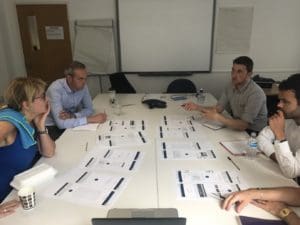Welcome back to the second part of this series The Do’s and Don’ts: Communication in Growing Teams based upon the insight and experience of Hubber, Amit Patel.

Amit Patel was previously the Lead UX Instructor at General Assembly, and now he runs his own education startup, Experience Haus, hosting creative courses, workshops and events for the curious — as well as connecting students with mentors within the industry.
Your company isn’t the only one struggling with communication
Last year, I was invited to a think-tank style breakfast consisting of designers and product people from across various government departments. The team that planned and hosted the event were called One Team Gov.
To my surprise, even for these teams and departments that we all expect to be as process-driven and as seamlessly connected as possible, communication and a lack of working relationships meant that projects were slow getting off the ground or not happening at all. I would not have predicted this, and maybe that was naivety on my part. But it made a perfect fit for my talk, as it highlighted the fact that poor communication can slow down and hold back any team, regardless of who they are. Next time you come across a team or company that is producing great work, take a look at how they are communicating which each other, as you’ll probably pick up a few tips for yourself.
Ask for clarification early
Another role I took on last year was working with an exciting fin-tech company that are based here in London. Having key stakeholders (in this case the CEO) and developers involved in the design process helped in getting clarity on complex issues, technical decisions, and business objectives. Had these core groups of people not been involved, a lot of assumptions would have been made; likely resulting in more time spent getting answers and a delay in the project.
This simple principle of gaining clarification, and engaging the key stakeholders, early on, also made some of the workshops we held more fun – even though we were completed exhausted by the end of them. Not only did we feel we had the right information and insights to help us build a much better product, there was a genuine excitement within the design team.
Build great working relationships
Involve non-designers
A skill that designers must possess is the ability to facilitate discussion and acquire knowledge from people across the company. On projects where I have had the most success I have prioritised the involvement of key stakeholders, developers and people across various departments when working through the design process. Think about it: all of these people are contributing in their own way to your company and its product.
In addition, this approach not only helps get everyone on the same page, but ensures all voices are heard and solidifies the direction being taken with product development. Plus as an added bonus, they will see and appreciate all the hard work you are doing.
It’s not just governance!
Simply putting a communication plan in place is not enough (e.g. who needs to speak to who and when) — it is more about creating good working relationships. To have a meeting is just the start, people must be given, or developed to a stage where they have the ability to challenge, discuss and truly care for each other. This is what is most important.
Challenge each other
To be able to provide constructive critique/feedback, and also be able to receive it, is critical. People in the team should feel you are receptive to feedback about your work.
Let’s be honest, some critical feedback can sting! When delivered in the right way, however, it becomes extremely useful in helping design quality products. Taking on feedback is yet another way to get information and insight about how to make your personal work and company product better. Be sure to deliver feedback by focusing on the work itself and avoid aiming feedback at the person and their character.
Care for each other
How well do you know everyone on your team? Or the other people in the company that you might be working with?
Now, I’m not suggesting that you go out for drinks every week, or do a daily lunch with all of your team. Nor do you need to know everything about each other’s lives. As you do build rapport and relationships with them though, you can focus on career aspiration, special skills and some of the problems they are trying to address where you are working. Trust me, it is so much easier to communicate, discuss ideas and share feedback with a team that you genuinely care about.
Haven’t read part one yet? Click here.



